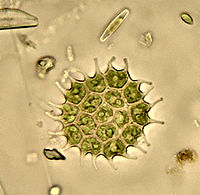- Chlorophyceae
-
Chlorophyceae 
Scientific classification Domain: Eukaryota Kingdom: Plantae Division: Chlorophyta Class: Chlorophyceae
Wille in Warming, 1884Orders[1] - Chaetopeltidales
- Chaetophorales
- Chlamydomonadales
- Chlorococcales
- Chlorocystidales
- Microsporales
- Oedogoniales
- Phaeophilales
- Sphaeropleales
- Tetrasporales
- Volvocales
The Chlorophyceae are one of the classes of green algae, distinguished mainly on the basis of ultrastructural morphology. For example the chlorophycean CW clade, and chlorophycean DO clade, are defined by the arrangement of their flagella. Members of the CW clade have flagella that are displaced in a "clockwise" (CW, 1–7 o'clock) direction e.g. Chlamydomonadales. Members of the DO clade have flagella that are "directly opposed" (DO, 12–6 o'clock) e.g. Sphaeropleales. They are usually green due to the dominance of pigments chlorophyll a and chlorophyll b.The chloroplast may be discoid, plate-like, reticulate, cup-shaped, spiral or ribbon shaped in different species. Most of the members have one or more storage bodies called Pyrenoids located in the chloroplast.Pyrenoids contain protein besides starch.Some algae may store food in the form of oil droplets.Green algae usually have a rigid cell wall made up of an inner layer of cellulose and outer layer of pectose.
Reproduction
Vegetative reproduction usually takes place by fragmentation or by formation of spores. Asexual reproduction is by flagelated zoosporangia. The sexual reproduction shows considerable variation in the type and formation of sex cells and it may be isogamous, anisogamous or oogamous.
They share many similarities with the higher plants, including the presence of asymmetrical flagellated cells, the breakdown of the nuclear envelope at mitosis, and the presence of phytochromes, flavonoids, and the chemical precursors to the cuticle.[2]
The following orders are typically recognised:
- Dunaliellales (e.g. Dunaliella)
- Volvocales (e.g. Volvox, Chlamydomonas)
- Chlorococcales (e.g. Nannochloris)
- Oedogoniales (e.g. Oedogonium)
- Sphaeropleales
- Chaetophorales
- Microsporales
- Tetrasporales (e.g. Tetraspora)
In older classifications, the term Chlorophyceae is sometimes used to apply to all the green algae except the Charales, and the internal division is considerably different.
The Orders of the Chlorophyceae as listed by: in Hoek, Mann and Jahns (1995)[3]
- Volvocales
- Chlorococcales
- Chaetophoroales
- Oedogoniales
Ulvophyceae by Hoek, Mann and Jahns (1995)
- Codiolales
- Ulvales
References
- ^ Guiry, M.D. & Guiry, G.M. (2007). "Class: Chlorophyceae taxonomy browser". AlgaeBase version 4.2 World-wide electronic publication, National University of Ireland, Galway. http://www.algaebase.org/browse/taxonomy/?id=4355. Retrieved 2007-09-23.
- ^ Raven, Evert and Eichhorn. The Biology of Plants 7th edition, pg. 335. W. H. Freeman and Company, New York, 2005.
- ^ Hoek,C.van den, Mann, D.G. and Jahns, H.M. 1995. Algae An Introduction to Phycology. Cambridge University Press, Cambridge
See also
External links
Classification of Archaeplastida / Plantae sensu lato Rhodophyta Cyanidiophyceae · Porphyridiophyceae · Compsopogonophyceae · Stylonematophyceae · Rhodellophyceae · Bangiophyceae · Florideophyceae (Hildenbrandiales, Acrochaetiales, Nemaliales, Batrachospermales, Corallinales, Gelidiales, Gracilariales, Ceramiales)Glaucocystophyceae Glaucocystis · Cyanophora · GloeochaeteViridiplantae/
Plantae
sensu strictoEuphyllophytaMoniliformopses (Equisetopsida, Filicopsida, Psilotopsida)
Spermatophyta: Gymnosperm (Pinophyta, Cycadophyta, Ginkgophyta, Gnetophyta) · MagnoliophytaSee also: list of plant ordersCategories:- Chlorophyceae
- Algae classes
Wikimedia Foundation. 2010.
